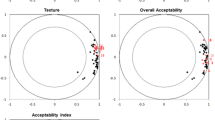Abstract
The effects of cowpea and amino acid supplementation on the protein quality and chemical characteristics of a maize-based West African traditional weaning food were studied. Process optimization for improved nutritive value was also determined. Supplementation of the traditional weaning food with cowpea increased the lysine, tryptophan and threonine content while the sulphur-amino acids decreased with increasing levels of cowpea. Further supplementation of 70:30 maize/cowpea blends with lysine, threonine or methionine did not significantly improve (p>0.05) protein quality in terms of the biological value (BV) and net protein utilization (NPU), although significant increases in the protein scores were noted. However, considerable improvements in the BV and NPU were recorded in blends fortified with either tryptophan alone or a combination of lysine, tryptophan, methionine and threonine. Cooking whole cowpea seeds for 45 min before incorporating in the blend formulation also significantly improved (p<0.05) the protein quality of maize/cowpea blends. The BV and NPU of blends containing 30% pre-cooked cowpea increased from 52 to 76% and 50 to 71% respectively compared to pure maize porridge. The protein content increased from 10 to 14% and the utilizable proteins more than doubled. The weight increase of experimental rats fed with these blends was comparable to that of rats on casein diet. A 30% supplementation of the maize-based weaning food with cowpea therefore greatly enhances the nutritive value especially when the cowpea is pre-cooked for 45 min. Use of chemical scores alone for such blends cannot be a reliable index of blend quality.
Similar content being viewed by others
References
Svanberg U, Fredrikson B, Gebrehiwot B, Taddesse WW (1987) Sorghum in a mixed diet for preschool children. Good acceptability with and without simple reduction of dietary bulk. J Trop Pedia 33: 181–185.
Jansen GR, Howe EE (1964) World problems in protein nutrition. Am J Clin Nutr 15: 262–267.
Oke OL (1975) A method for assessing optimum supplementation of a cereal based diet with grain legumes. Nutr Rep Int 11: 313–321.
Obizora IC (1983) Nutritive value of cowpea-bambara-groundnut-rice mixtures in adult rats. Nutr Rep Int 2: 709–712.
Okeiyi EC, Futrell FM (1983) Evaluation of protein quality of formulations of sorghum grain flour and legume seeds. Nutr Rep Int 28: 451–461.
Plahar WA, Leung HK, Coon CN (1983) Effects of dehydration and soy fortification on physicochemical, nutritional and sensory properties of Ghanaian fermented maize meal. J Food Sci 48: 1255–1259.
Oyeleke AO, Morton ID, Bender EA (1985) The use of cowpeas in improving a popular Nigerian weaning food. Br J Nutr 54: 343–347.
Uwaegbute AC, Nnanyelugo DO (1987) Nutritive value and biological evaluation of processed cowpea diets compare with local weaning foods in Nigeria. Nutr Rep Int 36: 119–129.
Akinyele IO, Fasaye OA (1988) Nutrient quality of corn and sorghum supplemented with cowpeas in the traditional manufacture of ogi. J Food Sci 53: 1750–1755.
Plahar WA, Leung HK (1983) Composition of Ghanaian fermented maize meal and the effect of soy fortification on sensory properties. J Sci Food Agric 34: 407–411.
Krogdahl Å, Holm H (1979) Inhibition of human and rat pancreatic proteinases by crude and purified soybean proteinase inhibitors. J Nutr 109: 551–558.
Del Rosario RR, Lozano Y, Pamorasamit S, Noel MG (1980) Trypsin inhibitor activity of legume seeds. Phil Agric 63: 339–344.
Ologhobo AD, Fetuga BL (1983) Investigations on the trypsin inhibitor, haemagglutinin, phytic acid and tannic acid contents of cowpea. Food Chem 12: 249–254.
Holm H, Krogdahl Å, Hanssen LE (1988) High and low inhibitor soybean meals affect human duodenal proteinase activity differently: In vitro comparison of proteinase inhibitor. Am Inst Nutr 0011-3166: 521–525.
MRC (1977) Dietary standard for laboratory animals. Report of the Laboratory Animal Center Diets Advisory Committee. Surrey, UK: Medical Research Center.
AOAC (1984). Official Methods of Analysis. Washington, DC: Association of Official Analytical Chemists.
Spackman DH, Moore S, Stein WH (1958) Automatic recording apparatus for use in the chromatography of amino acids. Anal Chem 30: 1190–1206.
Hirs CHW (1967) Determination of cystine as cysteic acid. Methods in Enzymology 11: 59.
Penke B, Ferencki K, Kovacs K (1974). Hydrolysis with mercaptoethanesulfonic acid. Anal Biochem 60: 45.
FAO/WHO/UNU (1985) Energy and protein requirements. Report of a joint FAO/WHO/UNU Expert Consultation. Geneva: WHO, Technical Report Series, No. 724.
Eggum BO (1973) A study of certain factors influencing protein utilization in rats and pigs. Copenhagen: National Institute of Animal Science, Publication No. 406.
FAO/WHO (1990) Protein quality evaluation. Report of a joint FAO/WHO Expert Consultation held in Bethesda, MD USA 4–8 December 1989. Rome: FAO.
Onayemi O, Potter NN (1976) Cowpea powders dried with methionine: preparation, storage, stability, organoleptic properties and nutritional quality. J Food Sci 41: 48–53.
Omueti O, Singh BB (1987) Nutritional attributes of improved varieties of cowpea. Human Nutr: Food Sci Nutr 41F: 103–112.
FAO (1970). Amino acid content of foods and biological data on proteins. Rome: FAO, Nutrition Division Publ. No. 24.
Akinyele IO, Onigbinde AO, Hussain MA, Omolulu A (1986) Physicochemical characteristics of 18 cultivars of Nigerian cowpeas and their cooking properties. J Food Sci 51: 1483–1485.
Abbey BW, Mark-Balm T (1988) Nutritional quality of weaning foods prepared from composite flours of maize, ungerminated and germinated cowpeas. Nutr Rep Int 38: 519–526.
Nti CA, Plahar WA (1994) Cowpea inhibition of human and bovine protease activities and the effects of processing. J Nutr Biochem (submitted).
Author information
Authors and Affiliations
Rights and permissions
About this article
Cite this article
Nti, C.A., Plahar, W.A. Chemical and biological characteristics of a West African weaning food supplemented with compea (Vigna unguiculata). Plant Food Hum Nutr 48, 45–54 (1995). https://doi.org/10.1007/BF01089199
Received:
Accepted:
Issue Date:
DOI: https://doi.org/10.1007/BF01089199




